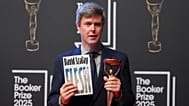The young artist's savvy and changes to the charts that reflect what people listen allowed her to break the band's long-held record.
Comparing any modern-day pop act to The Beatles is a fool's game — rock purists will sneer at the implication that anyone existing in the modern world could exist alongside The Fab Four, while pop diehards will claim that any attempt to frame the present in the past is a discounting of the modern day. But Ariana Grande's commanding of the top three spots on this week's Hot 100 singles chart, which ties a record set by The Beatles in 1964, does show how music consumption has changed since the days of Beatlemania, with the unison screams of the sixties now echoed in excitable fans' tweets of 2019.
Much like most of the other records-of-yore that have been broken by streaming-age upstarts, the comparison between what the Beatles and Grande isn't exact. In 1964, when The Beatles achieved their high-water mark of Hot 100 dominance — at one point, they actually had all of the top five spots on the chart — the U.S. labels that were able to release their work flooded the market with physical singles that listeners had to buy, in order to push their chart points higher. This was in addition to the full albums of both new and repackaged material that were being released at a fast-enough clip to capitalize on The Beatles' success.
Back then, in order to make the Hot 100, a song had to be released as a physical single, separate from a longer work. "Album cuts," as they were known, weren't eligible for the big chart until late 1998. In the mid-'90s, zeitgeist-defining songs — the Rembrandts' bouncy "Friends" theme "I'll Be There for You," No Doubt's glittery power ballad "Don't Speak" — didn't cross over to the Hot 100 despite being staples on radio and MTV because their labels hadn't released physical singles, hoping that intrigued listeners would instead buy the full albums to get the songs.
In December 1998, though, Billboard shifted the chart from a "singles" chart to one that just tracked the popularity of songs. This had the effect of turning albums with one or two big hit songs into $18.99 maxi-singles, bought so that listeners could "own" that song — and it, albeit briefly, helped goose the music industry's numbers enough that the Recording Industry Association of America introduced the Diamond Award, given to albums that shipped more than 10 million copies.
Of course, in the years that followed, the introduction of the post-physical music marketplace — first file-sharing, then digital downloads and finally (at least for now) streaming — slowed that once seemingly endless growth. The new listening landscape also helped the chart reach its current ability to properly track music-consumption habits: Paid digital download numbers were introduced into the chart's calculus in 2005, streaming data from AOL and Yahoo! arrived two years later, "on-demand songs" from Spotify and other services were brought into the mix in 2012 and, in 2013, Billboard began including YouTube plays in their Hot 100 calculus.
Further tweaks to the formula have happened since then, but the introduction of YouTube is probably the one that's had the most effect on the charts — and it definitely boosted Grande's standing in the week following the release of her album "thank u, next."
The album, which officially came out on Feb. 8, already had two popular singles out in the work before its release date: The title track, which came out in November, and the "My Favorite Things"-interpolating consumerist ode "7 Rings," which was released in January. Both those tracks make up two-thirds of Grande's current stronghold; the other is the album's final track, the 'NSync-sampling come-on, "break up with your girlfriend, I'm bored."
"Break up" was the beneficiary not only of its saucy conceit, but that the video for the track, a club fantasia where Grande plays femme fatale, came out on the same day as the album "thank u, next." This strategy of releasing songs in a music-and-video promotional blitz is both made possible by and a beneficiary of the streaming era, when releasing songs to the public and videos to the masses is as easy as uploading a file.
It was yet another savvy move by Grande, who's proven herself to be one of the artists most capable at keeping up with streaming-era demands of constant curiosity about both her music and her persona. It helps that she's a huge celebrity who's been in the public eye for more than a decade, and her relative youth compared to other female megastars (at 25, she's a year younger than Miley Cyrus) also makes her appealing to radio programmers trying to catch post-millennial ears.
"thank u, next" is also a pretty good record — one that has a bunch of potential radio hits in waiting. ("Needy," which was Grande's fourth-highest-charting "thank u, next" song on this week's chart, seems primed to be...next.) Grande's chatty social-media presence, ripe-for-discussion videos and aurally appealing, diaristic pop make her an ideal superstar for the always-on atmosphere of 2019. The increasingly winner-take-all nature of pop in the streaming era, when entire albums can flood the Hot 100 with their individual songs because of rule changes and rabid fanbases, only adds fuel to her dominance.
Maura Johnston is a writer and editor who teaches at Boston College. She has written for The New York Times, The Boston Globe, Time, Billboard, and Rolling Stone
This article was first published on NBC News' Think.















